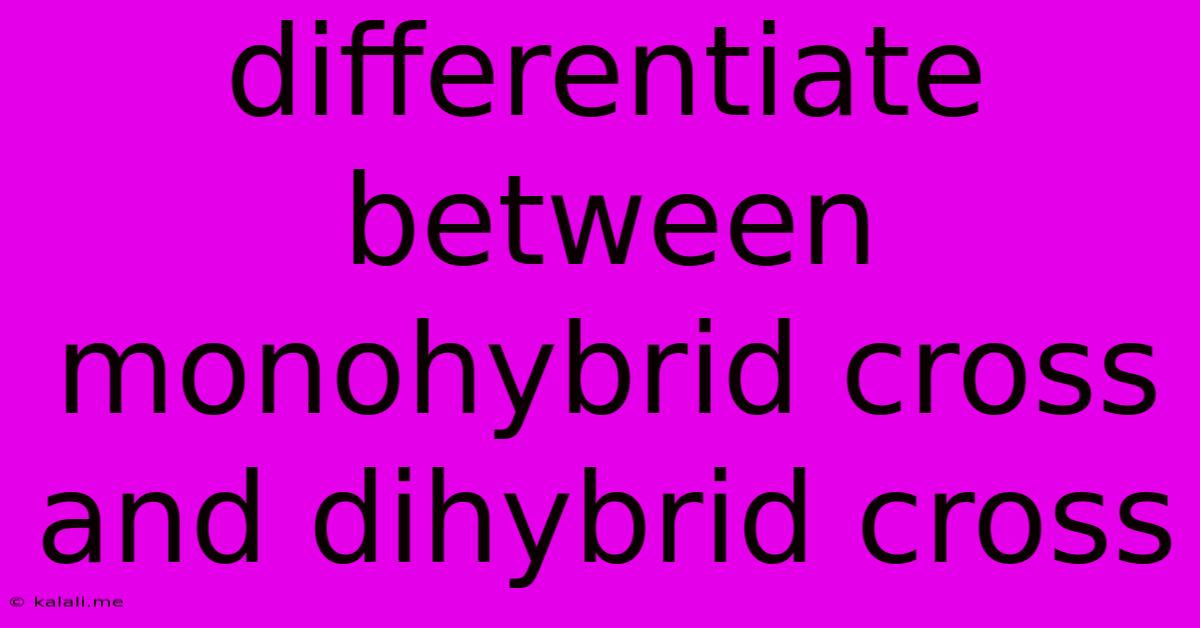Differentiate Between Monohybrid Cross And Dihybrid Cross
Kalali
Jun 15, 2025 · 3 min read

Table of Contents
Differentiating Monohybrid and Dihybrid Crosses: A Comprehensive Guide
Understanding monohybrid and dihybrid crosses is fundamental to grasping the principles of Mendelian genetics. While both involve tracking the inheritance of traits across generations, they differ significantly in their scope and the resulting phenotypic ratios. This article will clearly differentiate between these two crucial concepts, providing a comprehensive guide for students and enthusiasts alike.
What is a Monohybrid Cross?
A monohybrid cross focuses on the inheritance of a single gene. This means we are tracking only one specific trait with two contrasting alleles (variations of a gene). For instance, we might examine the inheritance of flower color in pea plants, where one allele codes for purple flowers (dominant) and another for white flowers (recessive). The classic example uses the letter "P" for purple and "p" for white.
Key Features of a Monohybrid Cross:
- One Trait: Only one characteristic is considered.
- Two Alleles: Each parent contributes one allele for the trait.
- Genotypic Ratio: Typically a 1:2:1 ratio (homozygous dominant: heterozygous: homozygous recessive).
- Phenotypic Ratio: Typically a 3:1 ratio (dominant phenotype: recessive phenotype). This assumes complete dominance, meaning the dominant allele completely masks the recessive allele.
Illustrative Example: Crossing two heterozygous pea plants (Pp x Pp) will result in offspring with a genotypic ratio of 1 PP: 2 Pp: 1 pp and a phenotypic ratio of 3 purple flowers: 1 white flower.
What is a Dihybrid Cross?
A dihybrid cross, on the other hand, examines the inheritance of two different genes simultaneously. This means we're tracking two separate traits with their respective alleles. For example, we might track both flower color (purple/white) and seed shape (round/wrinkled) in pea plants.
Key Features of a Dihybrid Cross:
- Two Traits: Two distinct characteristics are considered.
- Four Alleles: Each parent contributes two alleles, one for each trait.
- Genotypic Ratio: More complex than a monohybrid cross, often displaying a 1:2:1:2:4:2:1:2:1 ratio.
- Phenotypic Ratio: Typically a 9:3:3:1 ratio (assuming independent assortment and complete dominance for both traits). This ratio reflects the different combinations of phenotypes for the two traits.
Illustrative Example: Crossing two heterozygous pea plants for both flower color (Pp) and seed shape (Rr) (PpRr x PpRr) will yield a 9:3:3:1 phenotypic ratio. This translates to 9 plants with purple flowers and round seeds, 3 with purple flowers and wrinkled seeds, 3 with white flowers and round seeds, and 1 with white flowers and wrinkled seeds.
Distinguishing Features Summarized:
| Feature | Monohybrid Cross | Dihybrid Cross |
|---|---|---|
| Number of Traits | One | Two |
| Number of Alleles | Two (one from each parent for the trait) | Four (two from each parent, one for each trait) |
| Genotypic Ratio | 1:2:1 (typically) | More complex, often 1:2:1:2:4:2:1:2:1 |
| Phenotypic Ratio | 3:1 (typically) | 9:3:3:1 (typically) |
| Punnett Square Size | 2x2 | 4x4 |
Independent Assortment: A crucial concept in understanding dihybrid crosses is the principle of independent assortment. This principle states that during gamete (sex cell) formation, the alleles for different genes segregate independently of each other. This explains the diverse combinations of traits seen in the offspring of a dihybrid cross.
By understanding the distinctions between monohybrid and dihybrid crosses, one gains a solid foundation in Mendelian genetics and can accurately predict the inheritance patterns of traits within populations. These fundamental concepts are crucial for further exploration of more complex genetic phenomena.
Latest Posts
Latest Posts
-
Measurement Of Badminton Court For Doubles
Jun 15, 2025
-
Which Of These Substances Is A Compound
Jun 15, 2025
-
Lcm Of 12 4 And 8
Jun 15, 2025
-
Which Of The Following Are Balanced Equations
Jun 15, 2025
-
Group Of Stars That Form A Pattern
Jun 15, 2025
Related Post
Thank you for visiting our website which covers about Differentiate Between Monohybrid Cross And Dihybrid Cross . We hope the information provided has been useful to you. Feel free to contact us if you have any questions or need further assistance. See you next time and don't miss to bookmark.